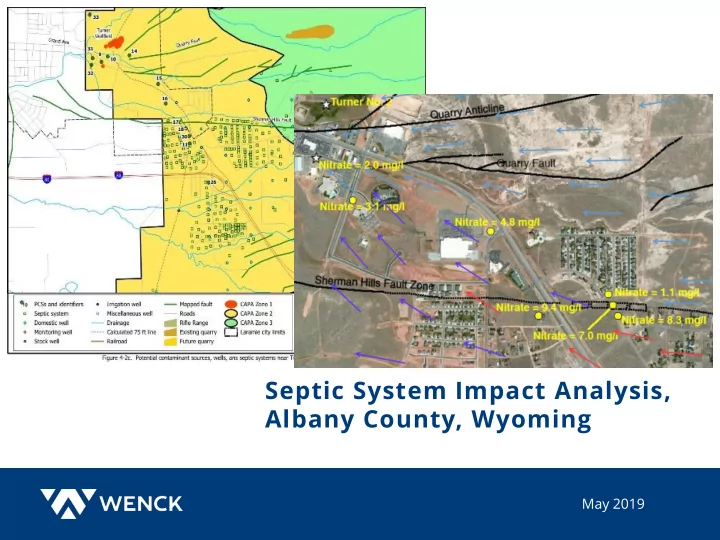

Septic System Impact Analysis, Albany County, Wyoming May 2019
STUDY PURPOSE The goal of this study was to answer the following questions related to soil nutrient removal capacity in the CAPA: Will soils within the unsaturated (vadose) • zone remove nitrogen prior to reaching groundwater? What nitrate concentrations will exist after • treatment by the septic system? What is the long term capacity of soils to • attenuate nitrogen within the area?
UNSATURATED ZONE MONITORING PROPOSAL: LYSIMETER INSTALLATION The goal of the emplacement of a lysimeters was to assess the soils capacity to attenuate nutrient concentrations throughout the vadose zone . Lysimeters are porous ceramic cups which are placed in the • unsaturated zone and will collect water due to a difference in osmotic pressures (soil to cup) After a period of time, the cup fills with water collected from the • unsaturated zone and the sampler removes it by installing a negative pressure and allowing the sample to flow from the cup to sample bottle for analysis For this study, Wenck installed these cups diagonally below the • infiltration pipes of the leach field at various depths. This allowed us to sample at depth intervals to identify the ability of the underlying soils to treat effluent 3
MONITORING NETWORK SITING Located over Casper outcrop • east of Satanka Septic system built within • last 10 years with detailed records 10+ feet of soil overlying • Casper Formation We considered 19 systems (3 • different types) and short listed to 7 systems. After both internal and • Albany County discussions and finding a willing landowner, we settled on the current system. 4
RANGE VIEW LANE SITE 5
TEST HOLE DRILLING
TEST HOLE DRILLING - CASPER
LYSIMETER DRILLING BELOW THE LEACH FIELD
LYSIMETER INSTALLATION
MONITORING NETWORK SETUP
SEPTIC TANK WATER QUALITY
SOIL ANALYSIS RESULTS
SOIL MOISTURE RESULTS
SOIL MOISTURE QUALITY PROFILE
CONCLUSIONS The unsaturated zone at this site is approximately 39% • efficient in removing nitrogen (all forms) from the septic tank to a depth of 35 feet through a combination of adsorption, denitrification, and dilution Soil moisture with nitrate concentrations in excess of • EPA and DEQ Class I standards (51-63 mg/L) is percolating through the unconsolidated sand alluvial fan deposits into the unsaturated Casper Formation The unsaturated zone at this site does not remove • sufficient nitrogen to protect the Casper Formation and by inference the Casper Aquifer from nitrate contamination
RECOMMENDATIONS Continue monitoring the unsaturated zone sampling network at this site • with landowner consent Install several similar monitoring networks at different properties with • different soil types or septic systems Preferably test an “enhanced treatment septic system” • Use these data to evaluate septic system design requirements in the • CAPA Consider extending city wastewater service to these areas or regional • collection and treatment systems Estimate nitrate loading to the CAPA assuming similar operating • conditions Make recommendations as data set grows •
PROCESS – WHAT WORKED • Coordination with County for site selection • Lysimeter installation approach using new augers and dry materials • Finding a site with adequate soil cover above the Casper Formation PROCESS – WHAT DID NOT WORK • Relying on septic system layout maps • Lysimeter sampling in cold weather 17
PROCESS – IMPROVEMENTS • Excavate to locate system margin before drilling • Allow more time to initially find sites and landowners willing to partner • Increase funding to cover professional services • System installation in the spring or fall • Concentrate sampling during spring through fall months • Install a downgradient monitoring well 18
FIELD SCALE APPROACH 1. Project area site selection 1. Field scale approach 2. 3- 45 degree holes (0-15ft) 2. Lysimeter installation 3. Strat hole defining field lithologies 4. Monthly sampling 5. Data analysis
SEPTIC SYSTEMS AND DRAINFIELDS Septic System Nutrient Attenuation is Governed by: System Maintenance and Owner’s • Actions Quality of Effluent Leaving Septic Tank • Daily Flow Rate • System Design and Drainfield Sizing • Soil Texture and Structure • Soil Moisture • Soil Geochemical Characteristics • Soil Organic Matter Abundance •
Recommend
More recommend